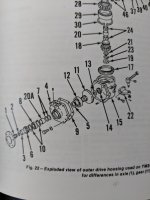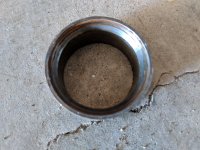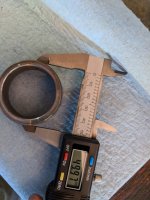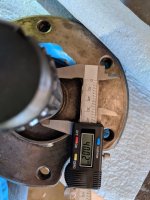OK, I'm with you now. I think from your photo that you are working on the wheel spindle.
Some more on shop manual and parts books: I got to looking at my books, and like you I have the OEM green Yanmar 240D parts book. I also have what sounds like the same I&T Shop manual covering the 240D plus other models. In addition, I have other shop manuals for other model Yanmars....but nothing else specifically for the 240D.
The original green Yanmar parts manual is good; I've rarely ever found those Yanmar parts books to be in error - although sometimes (rarely) Yanmar sent out addendums & errata to be added to some pages. The problem with the Yanmar parts books is that they specify dimensions on some parts but not others. They are pretty good on some collars, but not so much on spacers and bushings. The good thing is that when they call out dimensions I've found them to be accurate. And they are very good with bearings and bolt sizes.
Yanmar's OEM shop manuals are equally good and have more dimensions, but I don't have one for the 240D. And the OEM shop manuals are very model specific. They will cover variations within a model but for example the YM240 shop manual will not normally have the 4wd axle chapter. For that info, you have to have the YM240D shop manual.
As to the I&T manuals, they have good illustrations and a decent write up, but as you have probably already figured out they don't do a very good job in their index and lists that refer back to the drawings. Index numbers point to the wrong part, or no part, and their dimensions may be wrong, too. At every step, take the I&T manuals with a grain of salt. Admirable effort, but they tried to do too much.
If you can, get an OEM 240D shop manual. It has to cover the "D" model for 4wd info. I'll look around too.
Uh-Oh...BTW, my apologies about my rant about bearing prices.... I didn't realize just how much heavier the 240D axle is than the 195D front axle. The bearings are NOT $12.00 bearings - the 240D uses one each of the #6008 and 6211 in the spindle area - which are more on the order of $36.00 each. Here's a link to bearing dimensions and specs that is informative and might help calculating shim size, too.
McMaster-Carr
If you are working on the spindle like I think you are, how are you coming on the oil seal? From the drawing it looks like Yanmar cleverly put a wear sleeve (collar) between the ID of the oil seal and the spindle stub axle. Of course doing that creates another leak path, which they addressed with a hidden O ring inside the wear sleeve and what looks to be a groove to hold it in the spindle stub axle. Hmm....well, they got that half right. A single O ring would stop but also needs something to keep the wear sleeve from cocking relative to the axle shaft. They could use either another O ring, or maybe very careful sleeve dimensions so that it gets sandwiched and stays parallel with the axle because of that. If yours weeps a little when you are done we can put some more thought into improving the oil sealing on the inside ID of that wear collar.
Keep notes of the dimensions of sleeves, collars, bearings and such - I bet we will need them before done. Plus I'd like to put notes in my parts manual.
luck,
rScotty
Yup, working on front (stub) axle/wheel spindle that lives in the knuckle.
I have all the shop manuals, but had a hard time finding original for YM240D on eBay, so purchased one for YM240 two weeks ago. I also purchased a drivetrain manual for 135 through 240. I have to see what it turns out to be.
Like you said, t he oil seal (6) on the spindle seals around the wear collar (3) and housing cover (4). It had to be pressed into the housing cover (4). The wear collar had to be pressed onto axle (1) and o-ring (2).

I wonder if doubling up o-rings around axle would help. It is not covered in any literature I have, so I pushed o-ring all the way down on the axle and then pressed wear collar over it (the machined side down), I wonder if that would cause more of a problem. When I took it apart, the wear collar freely rotated on the axle and moved up-down about 3/16".
Here is the old wear collar for reference (here you can see the machined side)

I will measure all diameters (old and new appear to be exactly same, except the seal) and post them here.
Those are the bearings I bought. Pulled a seal on one side on each.




